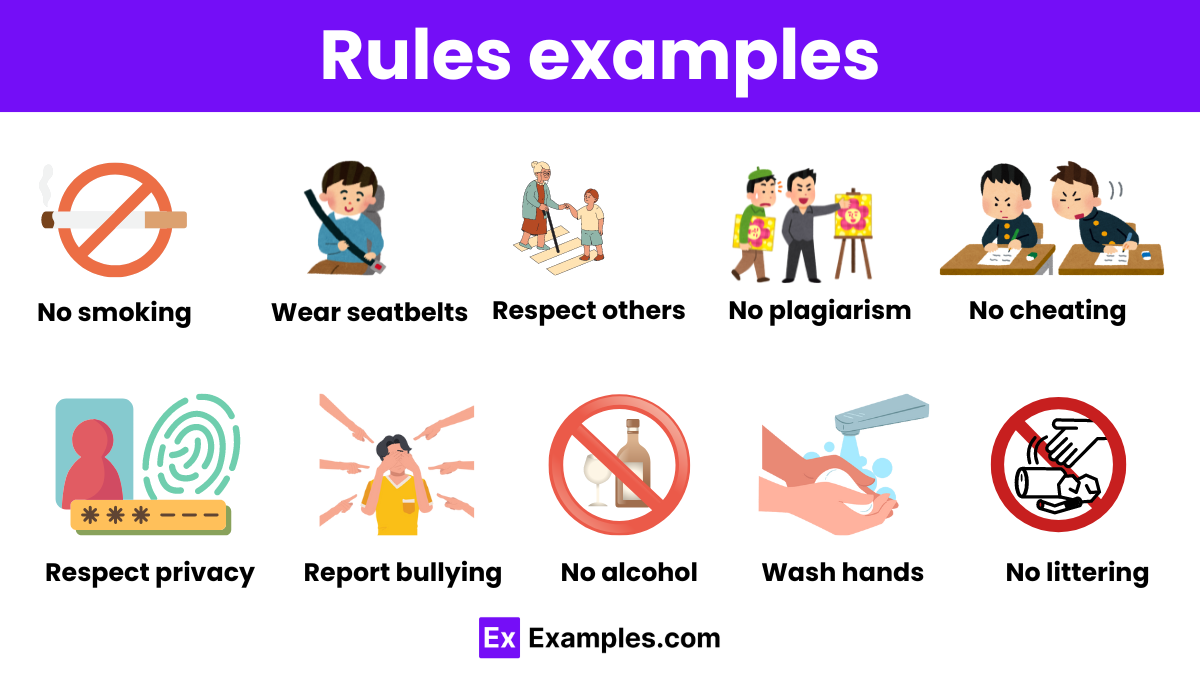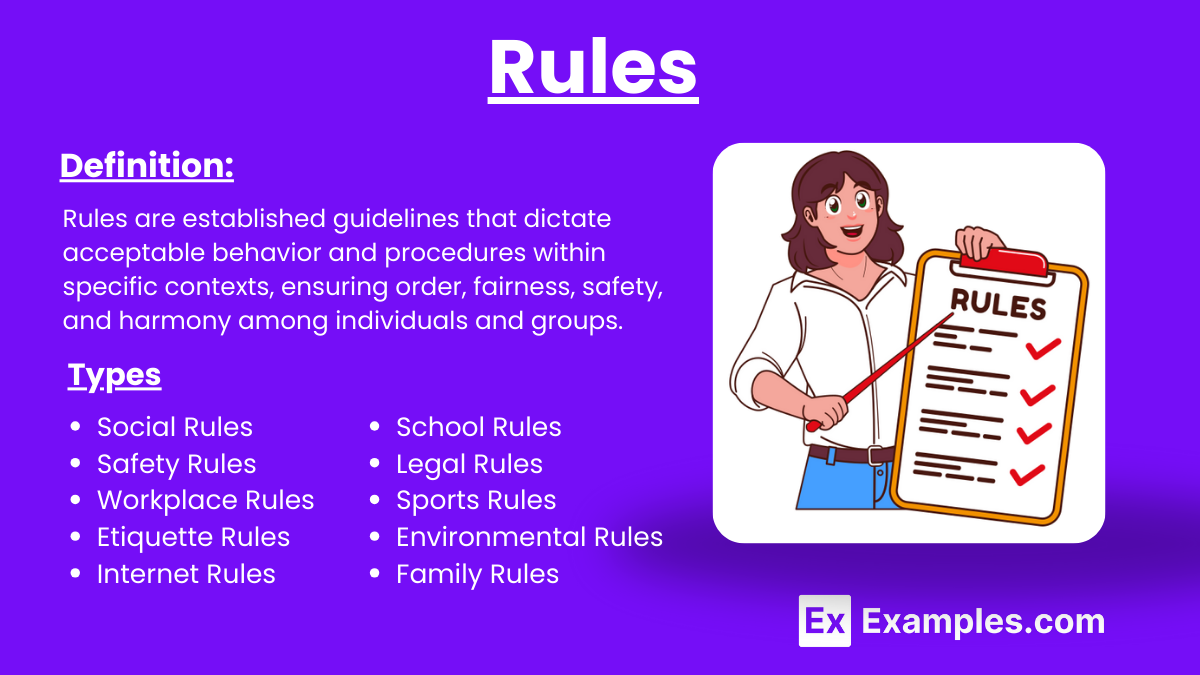20+ Rules Examples
Rules are guidelines established to ensure order and consistency within a system, community, or activity. They define what is acceptable behavior and outline consequences for violations. By providing structure, rules help maintain fairness, safety, and efficiency. They apply to various contexts, from societal laws and educational institutions to sports and games. Understanding and adhering to rules fosters mutual respect, accountability, and a sense of responsibility among individuals, contributing to a harmonious and organized environment.
What are Rules?
Rules are established guidelines that dictate acceptable behavior and procedures within a specific context. They ensure order, fairness, and safety by outlining what is permitted and what is not. Rules are essential for maintaining structure and harmony in various settings.
Rules examples

1. No running in hallways: Ensures safety by preventing accidents.
2. Quiet hours after 10 PM: Reduces noise disturbances.
3. No smoking: Promotes health and cleanliness.
4. Wear seatbelts: Enhances vehicle safety.
5. No littering: Keeps environments clean.
6. Attendance mandatory: Ensures participation.
7. Respect others: Maintains harmony.
8. No plagiarism: Encourages originality.
9. Hand in assignments on time: Promotes responsibility.
10. No phones during class: Reduces distractions.
11. Follow dress code: Maintains decorum.
12. No food or drink in labs: Prevents contamination.
13. No pets allowed: Ensures safety and cleanliness.
14. Obey traffic signals: Prevents accidents.
15. Use indoor voices: Reduces noise.
16. Wash hands before eating: Promotes hygiene.
17. No outside food: Supports local vendors.
18. Report bullying: Ensures safety.
19. Library books return on time: Ensures availability for others.
20. ID badges visible: Enhances security.
21. No cheating: Ensures fairness.
22. Fire drills mandatory: Prepares for emergencies.
23. Proper disposal of waste: Maintains cleanliness.
24. No alcohol on premises: Ensures safety.
25. Respect privacy: Maintains trust.
Types of Rules
- Social Rules: Govern interactions in society, promoting respect, politeness, and cultural norms to ensure harmonious living among individuals in a community.
- School Rules: Set guidelines for student behavior, attendance, and academic integrity to create a conducive learning environment and maintain order.
- Safety Rules: Designed to prevent accidents and injuries, these rules include guidelines for proper conduct in potentially hazardous situations and environments.
- Legal Rules: Enforced by government authorities, these laws regulate behavior to maintain public order, protect rights, and ensure justice.
- Workplace Rules: Establish standards for employee conduct, safety, and productivity, fostering a professional and efficient work environment.
- Sports Rules: Define how games are played, ensuring fair competition, player safety, and clarity in the conduct of sporting events.
- Etiquette Rules: Outline proper manners and behaviors in social settings, promoting courtesy and respectful interactions among individuals.
- Environmental Rules: Regulate activities impacting the environment, promoting conservation, sustainability, and the protection of natural resources.
- Internet Rules: Govern online behavior, including privacy, security, and content sharing, to create a safe and respectful digital space.
- Family Rules: Set expectations for behavior, responsibilities, and communication within a household, fostering a supportive and organized family dynamic.
Why Do We Have Rules?
- Order and Structure: Rules provide a framework that ensures order and structure in various environments.
- Safety: They establish guidelines to promote physical, emotional, and psychological safety for all.
- Behavioral Expectations: Crisis communication rules articulate expected behaviors, fostering a respectful and cooperative atmosphere during challenging situations.
- Consistency: They ensure fairness and consistency in decision-making and interactions.
- Learning Focus: By minimizing distractions and disruptions, rules help maintain focus on learning objectives.
- Accountability: Rules teach accountability, helping individuals understand consequences and develop responsibility.
What are Nature of Rules?
- Prescriptive: Define specific behaviors that must be followed, providing clear guidelines for acceptable actions and conduct.
- Proscriptive: Outline behaviors that are prohibited, ensuring individuals know what actions to avoid.
- Formal: Employee work rules are officially documented and enforced by authorities, providing a structured framework, ensuring behavior compliance and operational consistency..
- Informal: Unwritten rules guided by social norms and cultural expectations, influencing behavior through societal pressure.
- Universal: Apply to everyone within a given context, ensuring consistency and fairness.
- Contextual: Specific to certain situations or environments, tailored to particular needs and circumstances.
- Flexible: Allow for interpretation and adaptation based on context, promoting fairness and understanding.
- Rigid: Strictly enforced with little room for deviation, ensuring consistency and order.
- Temporary: Applicable for a limited time or specific situation, addressing immediate needs or concerns.
- Permanent: Long-lasting rules that provide enduring guidelines for behavior and expectations.
The Significance of Rules
- Ensure Order: Rules provide Structure and Organization, preventing Chaos and Confusion in various settings, from schools to workplaces and public spaces. These guidelines, including Capitalization Rules, ensure clarity and consistency in communication and documentation.
- Promote Fairness: By setting clear expectations, rules ensure that everyone is treated equally and fairly, reducing the likelihood of bias and discrimination.
- Enhance Safety: Safety rules protect individuals from harm and accidents, creating secure environments in homes, schools, workplaces, and public areas.
- Foster Responsibility: Adhering to rules encourages accountability and responsibility, teaching individuals the importance of following guidelines and respecting boundaries.
- Facilitate Learning: In educational settings, rules create a focused and disciplined environment, allowing students to learn effectively and teachers to teach efficiently.
- Maintain Social Harmony: Social rules and etiquette promote respectful interactions, reducing conflicts and fostering a sense of community and cooperation among individuals.
The Evolution of Rules
- Primitive Societies: Early humans established basic rules to ensure survival and cooperation, focusing on resource sharing, group safety, and social hierarchy.
- Ancient Civilizations: With the development of agriculture and permanent settlements, codified laws emerged, such as Hammurabi’s Code, to regulate complex societies and trade.
- Medieval Period: Feudal systems and religious doctrines shaped rules, with kings, lords, and the church imposing laws to maintain order and control over territories and people.
- Enlightenment Era: Philosophers like Locke and Rousseau influenced modern legal frameworks, emphasizing individual rights, social contracts, and the rule of law.
- Industrial Revolution: Rapid urbanization and technological advances required new regulations for labor, health, safety, and economic practices, leading to modern labor laws and regulations.
- Digital Age: The rise of the internet and globalization necessitated rules for cyber conduct, data privacy, and international cooperation, constantly evolving to address new challenges. Effective workplace safety rules are crucial for maintaining order and protecting employees.
Rules for kids
- Listen to Adults: Always pay attention and follow instructions from parents, teachers, and caregivers to stay safe, learn, and understand spelling rules.
- Share with Others: Share toys and resources with friends and siblings to promote kindness and cooperation.
- Say “Please” and “Thank You”: Use polite words to show respect and appreciation in everyday interactions.
- Clean Up After Yourself: Tidy up toys, books, and personal items after use to keep your space neat and organized.
- Ask Before Taking: Always seek permission before using or taking something that belongs to someone else to show respect for their belongings.
- Use Inside Voices: Speak softly indoors to maintain a calm and peaceful environment, especially in shared spaces like classrooms and libraries.
- Follow Bedtime Routines: Stick to a consistent bedtime to ensure you get enough sleep for good health and energy.
- No Running Indoors: Walk calmly inside to avoid accidents and ensure everyone’s safety.
- Wash Hands Regularly: Practice good hygiene by washing your hands before meals and after using the restroom to stay healthy.
- Be Kind to Everyone: Treat others with kindness, respect, and empathy, fostering positive relationships and a supportive community.
The Role of Rules in the Curriculum
- Establishing Norms: To create a positive learning atmosphere, establish norms and behaviors with clear expectations. These Abbreviation Rules guide respectful and productive interactions among students and educators
- Setting Boundaries: Clearly outline what is acceptable and what isn’t, ensuring clarity for both students and educators.
- Ensuring Safety: Rules often include safety protocols to protect everyone within the learning environment.
- Promoting Respect: Rules encourage respect for oneself, others, and the learning process.
- Supporting Learning Objectives: They align with educational goals, helping students focus on achieving academic milestones.
- Enforcing Accountability: Rules foster accountability, teaching students the consequences of their actions.
How are rules created?
Rules are typically established based on organizational values, legal requirements, and consensus among stakeholders.
What happens if rules are broken?
Consequences vary but often involve corrective actions or disciplinary measures to uphold compliance and accountability.
Who enforces rules?
Rules are enforced by educators, administrators, or designated authorities responsible for maintaining order and safety.
Can rules change?
Yes, rules can evolve based on feedback, changing circumstances, or new insights to better serve their intended purposes.
What is the purpose of classroom rules?
Classroom rules create a conducive learning environment by promoting respect, focus, and positive interactions among students.
How do rules contribute to safety?
Rules establish safety protocols, emergency procedures, and guidelines to prevent accidents or conflicts.
Are rules necessary in online environments?
Yes, rules are essential in online settings to ensure cybersecurity, respectful communication, and academic integrity.
Do rules vary across cultures?
Yes, cultural norms and values influence the creation and enforcement of rules, reflecting societal expectations.
How can rules be communicated effectively?
Rules should be clear, accessible, and regularly communicated through written policies, discussions, and visual aids.
What role do rules play in teamwork?
In teamwork, rules promote collaboration, coordination, and mutual respect among team members to achieve shared goals.



